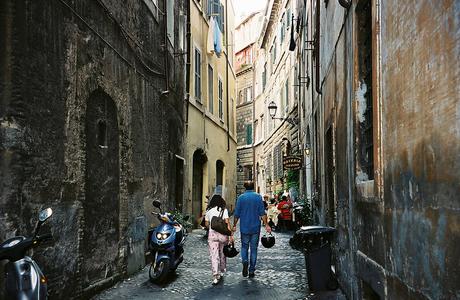 Rome
Rome
Villa Borghese
The Borghese Gardens are some of the most beautiful and intricate garden layouts you will find in Rome. A now famed attraction visited by many, the gardens sit on an area over 80 hectares of land close by to the Spanish Steps. These gardens are free to access so if you’re looking for a moment of quiet amongst the busy streets of Rome, this is it. The gardens began in 1866 by the Pope’s nephew Cardinal Scipione Borghese, however, it was given to the city in 1901 and was made into a public park in 1903. Now set in an English style garden, the beautiful grounds hold sculptures, monuments and a replica of Shakespeare’s Globe Theatre. Once a private vineyard, the Borghese Gardens is now the largest park in Rome and a central attraction in the heart of the city.
Pantheon
The Pantheon in Greece translates to ‘honour all Gods’, and this was what it once was for, as it had humble beginnings as a Roman temple over 2,000 years ago. Now a church, many are unsure how the Pantheon has survived several invasions and natural disasters over two millennia. It is known that Roman concrete was used to construct the building which is incredibly durable unlike the modernised version of concrete today. The Pantheon proudly boasts the largest unsupported dome in the world, with a giant hole in the center of it that catches the light. It is also the resting place of Italian kings and notable figures. The most well-known person to be buried in the Pantheon is the master Renaissance artist; Raphael. Step inside the impressive structure and marvel at the grandeur of an intricate design that rivals even its own illustrious temple façade.
Spanish Steps
An iconic attraction in Rome, climb the 138 steps and you’ll be greeted with a stunning view of the street level below. A long-time meeting point since 1723, the Spanish Steps architectural beauty has been captured by many of the artists who made their way here to paint and sketch. Whilst models of the time tried their best to capture the attention of these artists, eager to be their muses. Named for the Spanish embassy that sits near the base of the steps, the location is in a prime spot for more attraction viewing. To the right of the steps, you’ll come across the Keats-Shelley museum, once the house of English Romantic poets John Keats and Percy Bysshe Shelley. A close distance away is also the Trevi Fountain. Be prepared for crowds, as it is quite a favourite amongst tourists for photo ops, so if you make your way there bright early, you’ll have the quietest time alone.
Trevi Fountain
Next take a visit to the Trevi Fountain, the largest baroque style of its kind in the city. Begun in 1732 by Nicola Salvi, his death saw that the project wasn’t finished, so it was then picked up by Giuseppe Pannini in 1761. The fountain’s origins dates to the 9th century BC, however, it was updated over history to complement the style of art that was popular at the time. Another crowded touristy spot, around 7 million people come to Rome each year just to view the magnificent fountain. Don’t let this deter you however, for the fountain is said to have magical properties. With your back facing the fountain, toss a coin from your right hand over your left shoulder, this is said to ensure you will make a return trip to Rome one day, who would turn down another holiday to the gorgeous city?
Jewish Ghetto
The culturally rich Jewish Ghetto was established in 1555, and remains one of the oldest Jewish communities outside of the Middle East. The people of the Jewish quarter have had a tumultuous history with the city of Rome, in the 16th century, for example, saw the ghetto walled in and a Papal Bull written out by the Roman Catholic Church listing the jobs that the Jews were allowed to keep. Despite the mistreatment of the Jewish community, the people have still brought much culture with restaurants, synagogues and the Jewish Museum of Rome. It would be a shame to miss walking the streets of the enchanting quarter that is laden with ancient artefacts such as La Bocca Della Verita, a circular marble object with a man’s face carved into it, which is said to be a powerful lie detector.
Trastevere
This medieval neighbourhood lies only a stone’s throw away from the heart of Rome, just a short walk on a footbridge over the River Tiber. It’s easily one of the prettiest neighbourhoods in the area, where cobbled streets lead out to dainty shopfronts and fine dining. There are lots of free sites in the area, the most popular being the Piazza Santa Maria where locals come to people watch, meet up with friends or make their way to one of the hip bars that have popped up in contemporary times. The first square you’ll find yourself in after you cross the bridge is Piazza Trilussa, named after one of the neighbourhoods’ poets who was known for his love of alcohol and beauteous writing. There are many wonderful things about Trastevere and since it’s a less explored part of Rome, the perfect getaway from the crowds to walk through a truly authentic district.
Giancolo Hill
One of the best free activities you can treat yourself to in the city is a walk through Giancolo Hill all the way up to the top where you will reach Piazza Garibaldi, named after one of Italy’s greatest generals. Wonder up at the Acqua Paola fountain, a mammoth structure that was built in 1612, or Bramante’s Tempietto where 14th-century citizens believed that St. Peter was crucified. The walk along the hill alone is worth a visit as its picturesque greenery on both sides provides a stunning border for the stunning landscape that you will look out on to. In the distance, you will see the gardens of the Villa Borghese and the Colosseum.
If you’re after a guided Rome Tour, Sightseeing Tours Italy offers you the best sightseeing tours in Rome.
Recommended Rome Tours: Rome Day Tour with Vatican & Colosseum
Price: €119
Advertisements
